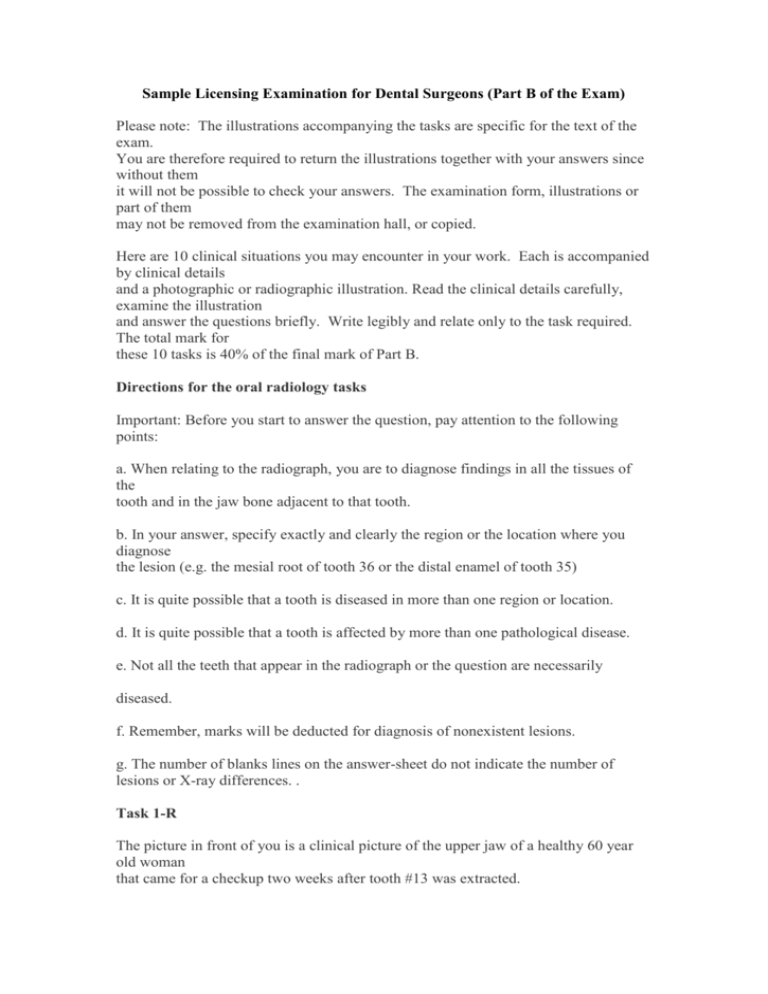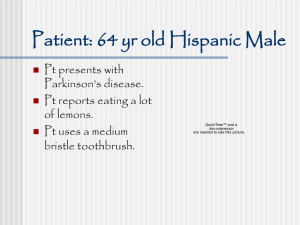Sample Licensing Examination for Dental Surgeons (Part B of the
advertisement

Sample Licensing Examination for Dental Surgeons (Part B of the Exam) Please note: The illustrations accompanying the tasks are specific for the text of the exam. You are therefore required to return the illustrations together with your answers since without them it will not be possible to check your answers. The examination form, illustrations or part of them may not be removed from the examination hall, or copied. Here are 10 clinical situations you may encounter in your work. Each is accompanied by clinical details and a photographic or radiographic illustration. Read the clinical details carefully, examine the illustration and answer the questions briefly. Write legibly and relate only to the task required. The total mark for these 10 tasks is 40% of the final mark of Part B. Directions for the oral radiology tasks Important: Before you start to answer the question, pay attention to the following points: a. When relating to the radiograph, you are to diagnose findings in all the tissues of the tooth and in the jaw bone adjacent to that tooth. b. In your answer, specify exactly and clearly the region or the location where you diagnose the lesion (e.g. the mesial root of tooth 36 or the distal enamel of tooth 35) c. It is quite possible that a tooth is diseased in more than one region or location. d. It is quite possible that a tooth is affected by more than one pathological disease. e. Not all the teeth that appear in the radiograph or the question are necessarily diseased. f. Remember, marks will be deducted for diagnosis of nonexistent lesions. g. The number of blanks lines on the answer-sheet do not indicate the number of lesions or X-ray differences. . Task 1-R The picture in front of you is a clinical picture of the upper jaw of a healthy 60 year old woman that came for a checkup two weeks after tooth #13 was extracted. A. Describe the lesion _________________________________________________________________ _________________________________________________________________ B. List two possible Diagnosis, the first being the most likely. ___________________________________________________________ Task 2-R The picture in front of you is of an 80 year old man who was hospitalized in the urology department with contamination in his urinary tract. He is taking anti-biotics; Taravid 400 mg per day for eight days. He complains about burning, taste loss and dryness in his mouth that has gotten worse in the last two days; A. Describe the findings that are in the picture; ___________________________________________________________ ___________________________________________________________ ___________________________________ B. List two differential diagnosis; ____________________________________________________________ ____________________________________________________________ C. What is the advised treatment; (Medicines and dosage) _________________________________________________ Task 3-R In front of you is a clinical picture and X-ray of the patient; A. By the clinical picture describe the clinical findings and dental age of the patient; __________________________________________________ B. List at least two differential diagnosis; __________________________________________________ _____________________________________________________________________ C. Looking at the X-ray make a diagnosis, and by which of these findings did you base this diagnosis; ____________________________________________________________________ Task 4-R In front of you is a picture of a 48 year old man suffering from high blood pressure and is being treated with OSMO-ADALATE. He complains of burning mostly on the cheek mucosa on both sides; A. Describe the findings; _________________________________________________ Task 5-R This is a picture of a 35 year old man complaining about a "bump" on his cheek that bothers him when he eats. He is otherwise healthy. The lesion appeared about 2 months ago and grew rapidly; A. Circle the diagnosis's which could match the lesion; 1. Irritation Fibroma 2. Moluscum Contagiosum 3. Lipoma 4. Squamous Cell Carcinoma B. List at least two differential diagnosis of the lesion; Task 6-R In front of you are bite wing X-rays of a 14 year old boy. List the kinds of diagnosis including the exact of each; Diagnosis Right Tooth 53 Diagnosis Left Tooth 63 54 64 55 65 16 26 83 73 84 74 85 75 46 36 Task 7-R In front of you is a Orthoradial X-ray (A) and an Excentric X-ray (B) From the distal direction of tooth 14. Decide if the root with the arrow pointing to it is the buccal root or the palatal root; Task 8-R Comparing the X-rays from Task-7 (A & B) A. List the diagnosis of the lesion's on the X-rays of teeth 14 and 16; B. Describe the pathogenesis in tooth # 14; Task 9-R Describe the pathology of each tooth in the following bite wing X-rays. Also describe any other pathology's in the X-ray. Indicate the exact pathology and exact location (distal or mesial of the crown of the tooth). Remember that extra listings of pathology lowers the grade. Pathology Tooth ______________________ 34 ______________________ ______________________ 35 24 ______________________ 25 ______________________ 36 ______________________ ______________________ ______________________ ______________________ ______________________ ______________________ Pathology Tooth ______________________ 26 ______________________ 37 ______________________ 27 ______________________ ______________________ Task 10-R In front of you is a periapical X-ray of a 48 year old woman. A. If you see pathology in this X-ray write them down with the exact location and the diagnosis or differential diagnosis of each lesion; 1.________________________________________________________ 2.________________________________________________________ 3._________________________________________________________ ______________________________________________________________ 4.___________________________________________________________ (The number of empty lines do not indicate the number of lesions in this picture) B. The treatment for each diagnosis will be; 1.___________________________________________________________ 2.___________________________________________________________ 3.___________________________________________________________ 4.___________________________________________________________ 5.___________________________________________________________ 2 You are now to carry out 5 clinical procedures. At the end of each procedure the recommended time and maximum marks (%) are indicated. The total mark for these 5 tasks is 60% of the final mark of this stage. PAY ATTENTION-Check carefully before you begin each task. The examiners will mark ONLY THOSE TEETH designated for the task. If, for any reason, a wrong tooth is prepared, the candidate will not receive any marks for this task. General Instructions 1. You MUST NOT dismantle the phantom head or the jaws or remove the tooth being treated from its place. 2. Water spray must be used with the high-speed turbine. 3. Teeth will not be replaced or exchanged during the course of your work. 4. You may use the instruments provided for you by the dental school and/or your own instruments. At the end of the exam you will be required to return the instruments provided. OPERATIVE TASK 1 Tooth #25 has minimum decay interproximally in the enamel both mesial and distal until the DEJ. Remove the decay and prepare the cavity for an amalgam restoration without touching the adjacent teeth. Do not restore the tooth with amalgam. Recommended working time 40 minutes (20%) OPERATIVE TASK 2 Tooth #35 has minimal decay interproximally in the enamel both mesial and distal until the DEJ. Remove the decay and prepare the cavity for an amalgam restoration without touching the adjacent teeth. Do not restore with amalgam. Recommended working time 40 minutes (20%) Task I in Fixed Prosthetics You are required to prepare tooth #16 for a porcelain-fused -to-metal crown, implementing all the principles of crown preparation. Please note that among the requirements for a porcelain-fused-to-metal crown attention must be paid to; 1. Preparation should be retentive with enough room for metal and porcelain 2 There should be no undercuts 3. Finishing line on the buccal aspect-shoulder and bevel, on the lingual aspectchamfer OR deep chamfer on buccal aspect and feather edge on lingual aspect. 4. Interproximally, continuous blended finishing line 5. Finishing line 1/2 mm above the gums 6 Path of insertion. 7* Do not damage adjacent teeth!!. Recommended working time 45 minutes (20%) Task II in Fixed Prosthetics You are requested to make a temporary crown for tooth #16 which was previously prepared for a crown, using a ball of acrylic. Pay special attention to the following: (1) Complete marginal fit (2) Tooth morphology (3) Contact area (4) Bite contact (5) Embrasure (6) A smooth finish surface Be careful, It is necessary to use PETROLATUM on the prepared tooth and adjacent teeth before preparing the temporary crown Recommended working time 45 minutes (20%) ENDODONTIC TASK Prepare an access cavity for a root canal on tooth 26. Identify the canal orifices with the implementation of all of the principles of endodontic access cavity preparation. The demands for this assignment are: 1. Proper placement of the access cavity 2. Proper outline form 3. Direction of drilling 4. Smooth cavity walls 5. Identification of canal orifices. Recommended working time 40 minutes (20%) SUMMARY A. 10 tasks of X-rays and diagnosis maximum 100%. This section is 40% of the final mark of part B of the examination. B. 5 Practical Tasks; 1. Conservative dentistry 1 Cavity preparation 20% 2. Conservative dentistry 2 Cavity preparation 20% 3. Prosthetic dentistry 1 Crown preparation 20% 4. Prosthetic dentistry 2 Crown prep (temp) 20% 5. Endodontics Access cavity Total 20% 100% This section is 60% of the final mark of Part B of the examination THE PASSING MARK FOR PART B IS 60%. Syllabus for National Licensing Examinations in Dentistry 1- Diagnosis * Langlais RP, Bricker SL, Cotton JA and Baker BR: Oral Diagnosis, Oral Medecine and Treatment Planning, WB Saunders Co., Philadelphia, last ed. * Sharav Y. Orofacial Pain. in Wall PB and Melzack R (eds): Textbook of pain. Churchill Livingstone, last ed,. 1989 2- Oral medicine * Wood NK. and Goaz PW. Differential Diagnosis of Oral Lesions. CV. Mosby, St. Louis, 4 th ed., 1991. 3- Oral radiology * Goaz PW. and White SC. Oral Radiologie - Principles and Interpretation, CV. Mosby , St. Louis, 2 nd ed, 1987 4- Oral Pathology * Regezi JA and Sciubba JJ. Oral Pathology. WB Saunders, Philadelphia, last ed. 5- Medical emergencies in the dental office * Little JW and Falace DA. Dental Management of the Medically Compromised Patient. CV Mosby Co., St. Louis, last ed. 6- Conservative dentistry * Baun, Phillips and Lund. Textbook of Operative Dentistry. WB Saunders, 2 nd ed 1985. * Newbrun E. Cariology. Quintessence Publishing Co., Berlin, third ed., 1987 7- Occlusion * Kraus BS, Jordan RE, Abrams LA. Dental Anatomy and occlusion, Williams and Wilkins Co., Baltimore, last ed. 8- Full denture * Hickey CJ, Zarb GA, Bolender CL. Baucher's Prosthodontics for edentulous Patients. CV Mosby Co., St. Louis, 1990. 9- Removable partial denture * Henderson D, Mc Givney GP, Castelberry DJ. Mc Cracken's Partial Removable Prosthodontics, CV Mosby Co., St. Louis, 1985. 10- Fixed partial dentures * Schillinburg HT, Hobo S, Whitestti LD : Fundamentals of Fixed Prosthodontic. Quintessence Publishing Co., Berlin, 1987. 11- Dental materials * Craig RG. Restorative Dental Materials, CV Mosby Co. last ed. 12- Pedodontics * Wei Shy. Pediatric care - total patient care, Lea & Fabiger, last ed. 13- Development and growth * Moyers RE. Handbook of Orthodontics, Year Book Medical Publishers, last ed. 14- Oral surgery and anesthesia * Kruger Go. Textbook of Oral and Maxillofacial Surgery. WB Saunders Co., Philadelphia, last ed. 15- Periodontics * Genco RJ, Goldman, Cohen DW. Contemporary Periodontics. CV Mosby, St. Louis, last ed. * Carranza AC, Newman MG. Clinical Periodontology. WB Saunders Co,. London, last ed. 16- Endodontics * Walton RE, Torabinejad M. Principles of Endodontics. WB Saunders Co., Philadelphia, last ed. 17- Implementation of knowledge * Bashkar SN. Orban's Oral Histology and Embriology. last ed. * Nolte WA. Oral Microbiology. CV Mosby Co., St. Louis, 1982. 18- Law * The dentist ordinance 1978. 19- Ethics * By- laws of the Israeli Dental Association (chapiter b,c,d) 1983. * Beauchamp TL and Childress JF Principle of Biomedical Ethics, third ed, New York Oxford University Press 1994. * Weinstein BD. Dental Ethics. Lea and Febinger, Philadelphia 1993.





